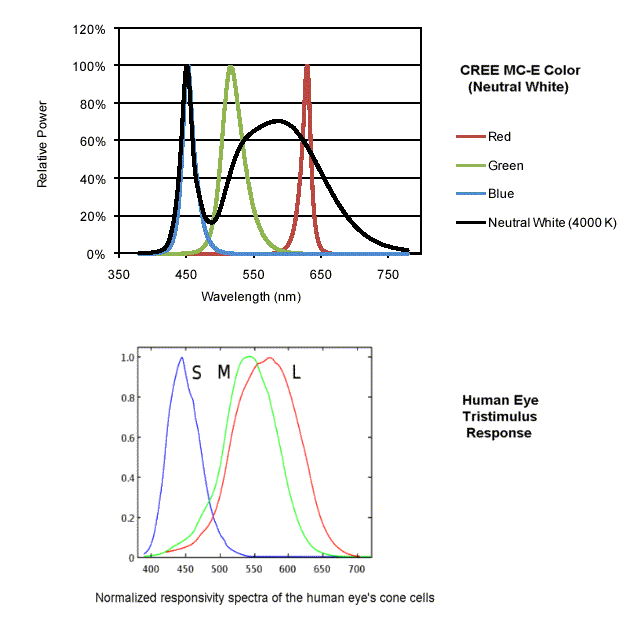Luminescent
Enlightened
- Joined
- Jun 26, 2007
- Messages
- 399
I'm afraid that wouldn't work.
What you have here is a white emitter plus three monochromatic emitters.
So by mixing the dies, you'd just get the white spectrum (either warm or cool, depending on which one you chose) with single-wavelength emission lines superimposed on it from the red green and blue dies.
What you are after is a continuous white spectrum with a variable colour temperature. Not the same thing at all. Probably not very easy to do with LEDs either, but this certainly isn't the way to do it.
First of all, the 'white' spectrum from white LEDS are no where near a 'continuous' spectrum. There is a HUGE fairly narrow blue spike created by leak through from the blue LED die used to drive the top phosphor layer. To get something even remotely 'white' they balance the blue spike with a strongly yellow biased broad spectrum hump created by the top phosphor layer.
Second, the nominal 'single color' LEDs are not lasers, and do not produce real monochromatic light. Their spectrums are quite wide compared to a laser, and though they are not wide enough to completely fill in the gaps between the spectrum spikes, they are more than wide enough to give a three color source with a CRI that will match or exceed what you can get with a 'white' LED.
Third, because the human eye itself, as well as nearly all photographic and video systems, are based on a set of tri-stimulus filters centered roughly at Red, Blue, and Green wavelengths, you can indeed get a fairly good simulation of various 'color temperatures' by adjusting the RGB balance. Sure it's not a real black body continuous spectrum, but your eye can't see that, it can only see three sample color bands, and if you tweak those levels to match the black body spectrum equivelents for say a 3200K black body, your eye would be fooled even though the spectrum would be somewhat discontinuous.
Indeed, in practical human vision and photographic applications, the well controlled wavelengths of the individual RGB LEDs, coupled with precise settings of output levels that is possible with separate emitters, could give much more precise and consitent color rendering than the typical 'luxeon lottery' found in white LEDS.
A more practical issue arises due to the off center arrangement of the 4 dies on the chip. The result would be that the colors would register and give a nice even white combined color balance only in the center. Around the edges, the colors would not register perfectly, creating a variable level of color mixing. This would create the appearance of a circular rainbow spectrum around the periphery of the beam circle.
I think 4 Sevens really missed the boat by not at least adding a 'continuous color change' mode that gradually mixes each color with it's adjacent color (rather than just hard switching to the next color) to form the complements and near complements in what would appear to the eye to be a continuously varying color rainbow spectrum.
For example, midway between RED and GREEN, with both the RED and GREEN LED's driven equally, you would get a brilliant fully saturated YELLOW. If you vary the mix, the apperent color tint would change. Want a less saturated yellow like amber? Fine, just mix in some BLUE.
User interface would be a little tricky to figure out, but the mind boggles at the possibilities . . .
- Luminescent



 )
)